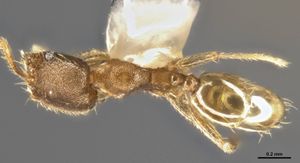Pheidole protensa
| Pheidole protensa | |
|---|---|

| |
| Scientific classification | |
| Kingdom: | Animalia |
| Phylum: | Arthropoda |
| Class: | Insecta |
| Order: | Hymenoptera |
| Family: | Formicidae |
| Subfamily: | Myrmicinae |
| Tribe: | Attini |
| Genus: | Pheidole |
| Species: | P. protensa |
| Binomial name | |
| Pheidole protensa Wilson, 2003 | |
In Veracruz, protensa has been found in both lowland rainforest and in montane cafetals, i.e., forest with coffee. (Wilson 2003)
Identification
See the description in the nomenclature section.
Distribution
Known from the type series; from near Cuichapa, Veracruz, 1600 m; and from Tuli Creek, near San Miguel, Nicaragua. (Wilson 2003)
Latitudinal Distribution Pattern
Latitudinal Range: 19.1897222° to 9.4817844°.
| North Temperate |
North Subtropical |
Tropical | South Subtropical |
South Temperate |
- Source: AntMaps
Distribution based on Regional Taxon Lists
Neotropical Region: Costa Rica, Guatemala, Honduras, Mexico (type locality), Nicaragua, Panama.
Distribution based on AntMaps
Distribution based on AntWeb specimens
Check data from AntWeb
Countries Occupied
| Number of countries occupied by this species based on AntWiki Regional Taxon Lists. In general, fewer countries occupied indicates a narrower range, while more countries indicates a more widespread species. |

|
Estimated Abundance
| Relative abundance based on number of AntMaps records per species (this species within the purple bar). Fewer records (to the left) indicates a less abundant/encountered species while more records (to the right) indicates more abundant/encountered species. |

|
Biology
Castes
Worker
Minor
Images from AntWeb
   
| |
| Not Provided. Worker. Specimen code casent0282721. Photographer Adam Lazarus, uploaded by California Academy of Sciences. | Owned by EPEC. |
Nomenclature
The following information is derived from Barry Bolton's Online Catalogue of the Ants of the World.
- protensa. Pheidole protensa Wilson, 2003: 489, figs. (s.w.) MEXICO.
Unless otherwise noted the text for the remainder of this section is reported from the publication that includes the original description.
Description
DIAGNOSIS A very small, yellow member of the flavens group, distinguished in the major by an elongated head entirely covered dorsally with longitudinal carinulae, which grow faint and curve inwardly in the posterior third of the head to converge toward and meet at the midline, becoming horizontal near the occiput.
Major: also with broken transverse carinulae on pronotal dorsum; a small but distinct mesonotal convexity; propodeal spines reduced to denticles; and a large propodeal spiracle.
Minor: all of head and mesosoma foveolate and opaque; propodeal spines reduced to denticles.
Similar to Pheidole browni, Pheidole casta, Pheidole mera, Pheidole olsoni and Pheidole prolixa, but easily distinguished by the above traits.
MEASUREMENTS (mm) Holotype major: HW 0.60, HL 0.82, SL 0.34, EL 0.10, PW 0.32. Paratype minor: HW 0.38, HL 0.44, SL 0.34, EL 0.06, PW 0.36.
COLOR Major and minor concolorous medium yellow.
Figure. Upper: holotype, major. Lower: paratype, minor. Scale bars = 1 mm.
Type Material
MEXICO: Las Hamacas, 17 km north of Santiago Tuxtla, Veracruz, col. E. O. Wilson. Museum of Comparative Zoology
Etymology
L protensa, stretched out, referring to the somewhat elongate head of the major.
References
- Wilson, E. O. 2003. Pheidole in the New World: A dominant, hyperdiverse ant genus. Harvard University Press, Cambridge, MA. (page 489, fig. major, minor described)
- Varela-Hernández, F., Flores-Zapoteco, D. 2024. New Miocene Mexican amber ant (Formicidae, Myrmicinae) of the genus Pheidole Westwood, 1839. Historical Biology, pp. 1–6 (doi:10.1080/08912963.2024.2312403).
References based on Global Ant Biodiversity Informatics
- Ahuatzin D. A., E. J. Corro, A. Aguirre Jaimes, J. E. Valenzuela Gonzalez, R. Machado Feitosa, M. Cezar Ribeiro, J. Carlos Lopez Acosta, R. Coates, W. Dattilo. 2019. Forest cover drives leaf litter ant diversity in primary rainforest remnants within human-modified tropical landscapes. Biodiversity and Conservation 28(5): 1091-1107.
- Dattilo W. et al. 2019. MEXICO ANTS: incidence and abundance along the Nearctic-Neotropical interface. Ecology https://doi.org/10.1002/ecy.2944
- De la Mora, A., J. A. Garcia-Ballinas, and S. M. Philpott. 2015. Local, landscape, and diversity drivers of predation services provided by ants in a coffee landscape in Chiapas, Mexico. Agriculture, Ecosystems & Environment 201: 83-91.
- Longino J. T. L., and M. G. Branstetter. 2018. The truncated bell: an enigmatic but pervasive elevational diversity pattern in Middle American ants. Ecography 41: 1-12.
- Longino J. et al. ADMAC project. Accessed on March 24th 2017 at https://sites.google.com/site/admacsite/
- Ottonetti L., L. Tucci, F. Frizzi, G. Chelazzi, and G. Santini. 2010. Changes in ground-foraging ant assemblages along a disturbance gradient in a tropical agricultural landscape. Ethology Ecology & Evolution 22: 7386.
- Vásquez-Bolaños M. 2011. Lista de especies de hormigas (Hymenoptera: Formicidae) para México. Dugesiana 18: 95-133
- Wilson, E.O. 2003. Pheidole in the New World: A Dominant, Hyperdiverse Genus. Harvard University Press


